Living in Canada:
Montreal
Overview
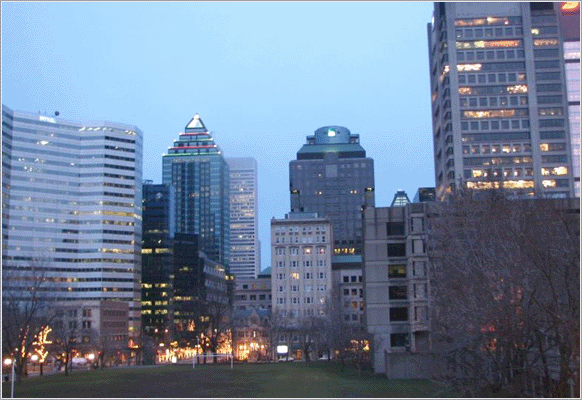 View of Montreal from McGill
View of Montreal from McGill
Montreal ranked 22nd in the Mercer Human Resource Consulting annual international survey that ranked 215 cities around the globe, based on 39 criteria measuring such quality-of-life determinants as personal safety and social, economic and environmental conditions.
Montreal is the second-largest city in Canada and the largest city in the province of Quebec. Originally called Ville-Marie ("Mary City"), the city had come to be known as Montréal by the 18th century, a name derived from the French Mont Royal ("Mount Royal"), the name of the three-head hill at the heart of the city.
Formerly the largest metropolis of Canada (a distinction since acquired by Toronto), it is the second-largest French-speaking city in the Western world, after Paris.
The Canadian 2006 Census reports that the census metropolitan area (CMA) of Montreal was home to the third-largest Canadian Immigration population in Canada, with 740,400 Canadian immigrants, accounting for 12% of the country's total Canadian immigrant population. Montreal trailed only Toronto (37.5%) and Vancouver (13.4%).
In Montreal the Canadian Immigration population is growing faster than the Canadian-born population. Between the 2001 and 2006 censuses, Montreal's Canadian immigrant population increased by 19%, nine times the growth rate of Montreal's Canadian-born population (2.1%).
Geography and Climate
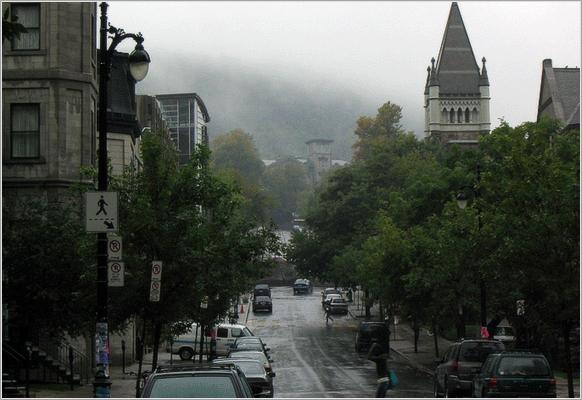 McTavish Street on a foggy day
McTavish Street on a foggy day
Montreal is located in the southwest of the province of Quebec, on the Island of Montreal at the joining of the Saint Lawrence and Ottawa Rivers. The port of Montreal lies at one end of the St. Lawrence Seaway, which is the river gateway that stretches from the Great Lakes into the Atlantic Ocean. Montreal is bordered by the St. Lawrence river on its south side, and by the Rivière des Prairies on the north.
Montreal lies at the meeting of several climatic regions and thus the climate in Montreal varies greatly. Precipitation is abundant with an average snowfall of 2.25 metres per year in the winter. Regular rainfall throughout the year averages 900 millimetres. Summer is the wettest season statistically, but it is also the sunniest.
| Top Regions of Birth for Recent Immigrants | ||
|---|---|---|
| Birth Region | Population | Percent |
| United States of America | 3,140 | 1.9% |
| Central America | 5,470 | 3.3% |
| South America | 13,170 | 8.0% |
| Western Europe | 12,005 | 7.3% |
| Eastern Europe | 21,400 | 12.9% |
| Southern Europe | 2,550 | 1.5% |
| Northern Europe | 1,240 | 0.7% |
| Western Africa | 4,490 | 2.7% |
| Eastern Africa | 3,070 | 1.9% |
| Northern Africa | 30,665 | 18.5% |
| Central Africa | 5,145 | 3.1% |
| Southern Africa | 55 | 0.1% |
| West Central Asia and the Middle East | 15,310 | 9.3% |
| Eastern Asia | 18,035 | 10.9% |
| Southeast Asia | 5,610 | 3.4% |
| Southern Asia | 12,215 | 7.4% |
| Oceania and other | 440 | 0.3% |
Montreal Immigration Profile
The Canadian 2006 Census shows that new immigrants who settle in Montreal come from every part of the world, especially francophone countries. Like many other cities across Canada in 2006, Asia and the Middle East was the leading source of recent Canadian immigrants for Montreal. While a large portion of newcomers to Toronto and Vancouver were from Asia (69.8% and 78.2% respectively), only one-third (31%) of the new Canadian immigrants living in Montreal were from that part of the world. Africa (26%) was another leading contributor of Canadian immigrants that settled in Montreal.
During the period of 2001 to 2006 Montreal became home to 8,440 new Canadian immigrants. The chart to the left shows the regions of birth for the recent immigrants according to the Canadian 2006 Census.
While three-quarters of the recent Canadian immigrants in Montreal had a mother tongue other than English or French, 94.4% of them reported that they were able to carry on a conversation in English or French.
Economy & Job Opportunities for Immigrants
When looking for a wide variety of career options, consider Montreal as an Immigration destination. Montreal is an important centre of commerce, industry, culture, finance, and world affairs.
Montreal industries include aerospace, electronic goods, pharmaceuticals, printed goods, software engineering, telecommunications, textile and apparel manufacturing, tobacco and transportation. The service sector is also strong and includes civil, mechanical and process engineering, finance, higher education, and research and development. In 2002, Montreal ranked as 4th largest centre in North America in terms of aerospace jobs.
Montreal is a major port city along the Seaway, a deep-draft inland waterway links it to the industrial centres of the Great Lakes. It is still the largest inland port in the world. As one of the most important ports in Canada, it remains a trans-shipment point for grain, sugar, petroleum products, machinery, and consumer goods. For this reason, it is the railway hub of Canada and has always been an extremely important rail city; it is the eastern terminus of the Canadian Pacific Railway and home to the headquarters of the Canadian National Railway.
Montreal is also a centre of film and television production, primarily but not exclusively for French Canadian productions. The headquarters and five studios of the Academy Award-winning documentary producer National Film Board of Canada can be found here, as well as the head offices of Telefilm Canada, the national feature-length film and television funding agency.
The video game industry is also booming in Montreal since 1997, coinciding with the opening of Ubisoft's studio in the area. As of today (2007), the city has attracted world leading game developers and publishers studios such as Ubisoft, EA, Eidos Interactive, Artificial Mind and Movement, Strategy First and many more. Every year, this industry is generating billions of dollars and thousands of jobs in the Montreal area only.
Education for Dependant Children and Post Secondary
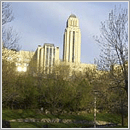 Université de Montréal, Roger-Gaudry pavilion
Université de Montréal, Roger-Gaudry pavilion
If education is an important factor in choosing an Immigration destination, think about Montreal. With access to six universities and twelve junior colleges in an 8 kilometer, Montreal has the highest concentration of post-secondary students of all major cities in North America.
English-language elementary and secondary public schools in the Greater Metropolitan Montréal Area are operated by the English Montreal School Board and the Lester B. Pearson School Board. French-language elementary and secondary public schools in Montreal are operated by the Commission scolaire de Montréal (CSDM), Commission scolaire Marguerite-Bourgeoys (CSMB) and the Commission scolaire Pointe-de-l'Île (CSPI).
The education system in the province of Quebec is slightly different from other systems in North America. Between the High School and University levels, there is an additional college level called "Cégep". It is at the same time a preparatory school (preparing students for admission at the University) and a technical school (offering courses which lead to technical diplomas and specializations). In Montréal, there are 17 Cégeps offering courses in French and 5 in English.
Francophone universities include the Université de Montréal, Université du Québec, and the Université de Sherbrooke (Located in Sherbrooke, campus in Longueuil)
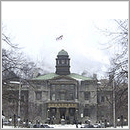 McGill University, Arts Building
McGill University, Arts Building
The Université de Montréal offers more than 250 undergraduate programs and more than 250 graduate programs, including 71 doctoral programs. It is Quebec's largest research institution and one of the largest in Canada, allocating close to $394 million to research conducted in more than 150 research centres. It is also the second largest French language university in the world, after the Sorbonne in Paris.
English-language universities include the notable McGill University and Concordia University.
McGill University is a publicly funded, co-educational research university located in the city of Montreal. McGill has 21 faculties and professional schools and offers degrees and diplomas in over 300 fields of study. The university ranked first among Canadian medical-doctoral universities in Maclean's 2006 University Rankings issue for the second year in a row, and is among the top 25 universities in the world according to the 2006 Times Higher Education Supplement. McGill and its affiliated hospitals were awarded $423 million in research funding in 2004-05.
Arts & Culture
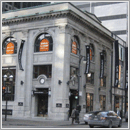 Banana Republic on Saint Catherine Street
Banana Republic on Saint Catherine Street
The cultural heart of classical art and the epicenter of many summer festivals, the Place des Arts is a complex of different concert and theater halls surrounding a large open-spaced square downtown. The Place des Arts harbors the headquarters of Montreal Symphony Orchestra (MSO), which perform in its halls regularly. Montreal is the cultural centre of Quebec, and of French-speaking North America as a whole. The city is Canada's centre for French language television productions, radio, theater, film, multimedia and print publishing. The Quartier Latin is a neighborhood crowded of cafés animated by this literary and musical activity.
The plaza on Place des Arts is the home of the most important events during several musical festivals, including the Montreal International Jazz Festival and Montreal Francofolies, a festival of French-speaking song artists. During the seven-to-ten days that each of the two festivals lasts, shows are held in a wide variety of venues, from relatively small clubs to the large halls of Place des Arts. Some of the outdoor shows are held on cordoned-off streets while others are on terraced parks. The most popular festival, in terms of attendance, is the Just For Laughs Festival. A comedy festival held in both languages, it features comedians, humorists, and stand-ups from all over the world. The Montreal Fireworks Festival also attracts a lot of attention. On the evenings of competition, tens of thousands of people watch the fireworks for free on their roofs or from locations nearby the competition. Other festivals in Montreal include Pop Montreal, The Fringe festival and Nujaz.
Montreal's night life is particularly dynamic. The most active neighborhoods then are rue St-Laurent, Downtown (Crescent Street, Sainte-Catherine Street), Quartier Latin (Saint Denis Street), and Plateau Mont-Royal. The city is increasingly becoming known for its mainstream rave festivals such as the Black and Blue Festival attracting thousands of ravers to the city every Canadian Thanksgiving weekend, as well as the Bal en Blanc held every Easter Sunday, also attracting over 15,000 attendees every year.
Restaurants in Montreal are particularly rich of the contributions from the different cultural communities that live in the city. Jewish culture has contributed two of Montreal's most distinctive dishes, smoked meat sandwiches and Montreal style bagels.
Sports & Recreation
The biggest sport following in Montreal clearly belongs to hockey – and the city is famous for its hockey-hungry fans. The Montreal Canadiens are one of the Original Six NHL teams, and boast the greatest number of Stanley Cup championships at 24.
Montreal is also the site of two high-profile racing events each year: the Canadian Grand Prix, and the Molson Indy Montreal of the Champcars Series. Both races take place at the Circuit Gilles Villeneuve on Île Notre-Dame. As of December 2006, NASCAR is in talks with city officials and the track promoter about a possible racedate for the Busch Series in August 2007.
The Montreal Alouettes of the CFL draw packed crowds at the small but picturesque Molson Stadium. University football receives increasing support, with the McGill Redmen, Concordia Stingers, and Université de Montréal's Carabins playing in Montreal. The city's USL First Division soccer team is called the Montreal Impact. Montreal has also been slated to have a Can-Am League team beginning in 2008.
Montreal hosted the first ever World Outgames in the summer of 2006, attracting over 16,000 particiants engaged in 35 sporting activities. They were the biggest sporting event in the city since the Summer Olympics of 1976.
The Montreal games of the FIFA U-20 World Cup Canada 2007 will be held at the Olympic Stadium.
Montreal has a well developed network of bicycle paths. Bike rentals are available at the Old Port of Montreal, as well as quadricycles, inline skates, children trailers, and segways. Five beaches around the island, in addition to a network of parks that include one on the Mont Royal, offer a set of recreational activities enjoyed by the local population.
| Professional Sports Teams | |||
|---|---|---|---|
| Club | League | Sport | Venue |
| Montreal Canadiens | NHL | Hockey | Bell Centre |
| Montreal Alouettes | CFL | Football | Percival Molson Memorial Stadium Olympic Stadium |
| Montreal Impact | USL | Soccer | Complexe sportif Claude-Robillard |
| Montreal Royal | ABA | Basketball | Centre Pierre Charbonneau |
| Montreal Mission | NRL | Ringette | Various |